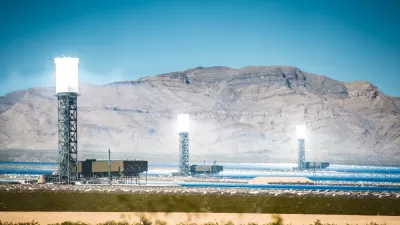The EPA intends to review the rulemaking process behind the mercury rule, the subject of a landmark Supreme Court ruling in 2015, to place more value on a rule's compliance cost to industry and less to its beneficial impact on human health.
On Aug. 29, "the Trump administration took a crucial step toward de-emphasizing the life and health benefits in its [rulemaking] when the Environmental Protection Agency said it would rethink a major regulation that restricts mercury [plus arsenic and other toxic] emissions by coal [and oil] -burning power plants," report Coral Davenport and Lisa Friedman for The New York Times.
The review of the cost-benefit analysis process "fits into a far-reaching administration strategy to loosen environmental rules affecting countless other industries for years to come by adjusting the factors used to judge the benefits to human health that the rule has brought," add Davenport and Friedman.
The 2011 regulation in question, known as the mercury and air toxics standards (MATS) rule, "is among the costliest but most effective clean-air policies put forth by the Environmental Protection Agency," they add. "Utilities estimate they have spent $18 billion installing clean-air technology, and mercury pollution has fallen by nearly 70 percent [pdf]."
Central to the review will be how to, or perhaps even whether, to account for "co-benefits," a term more often applied to reducing greenhouse gas emissions.
[I]n the case of the mercury rule, the Obama administration found between $4 million to $6 million in health benefits directly from curbing mercury. But it further justified the regulation by citing an additional $80 billion in health benefits a year by, among other things, preventing as many as 11,000 premature deaths.
Those savings come from a reduction in particulate matter linked to heart and lung disease that also occurs when cutting mercury emissions.
The rule was initially resisted by industry, leading to a 5-4 landmark Supreme Court decision in 2015, Michigan v. EPA (posted here by Planetizen editor James Brasuell) in favor of the plaintiffs, ruling that the EPA had to more properly account for costs incurred by industry. The EPA rewrote that part of the rule, which went into effect the following year after the Supreme Court refused to hear an appeal by 20 states seeking to block its implementation. Now EPA wants to revisit the cost-benefit analysis aspect of the 2011 rule.
“This goes way beyond just weakening the mercury rule,” said Alan Krupnick, an economist at Resources for the Future, a nonpartisan Washington research organization. “This is part of a change that would give the Trump administration a way to more easily justify loosening many other pollution regulations, such as rules on smog, and rules on climate-change pollution.”
"Nearly all U.S. coal plants now comply with the EPA mercury rule," reported Jeff McMahon for Forbes in July 2016. However, there are some notable holdouts, such as Nebraska's largest power plant (see 1998 emissions [pdf]), the topic of a related post last month on another EPA rule known as New Source Review and EPA's newly proposed Affordable Clean Energy rule.
Revisiting the MATS rule bears similarity to the regulatory rollback of light-duty vehicle greenhouse gas emissions standards announced last month in that the Trump administration is proceeding over the concerns of the regulated industry – the auto industry.
The electric utilities that operate the nation’s coal-fired plants, and thus are heavily affected by the mercury rule, are urging the administration to leave the rule alone. They have already spent billions of dollars to become compliant, the utilities say, so changes are of little benefit to them.
The article point to two groups that pushing the administration to redo the rule: the coal industry and conservative think tanks:
- The coal industry, particularly "Robert E. Murray, the C.E.O. of Murray Energy Corp., who has donated to Mr. Trump’s inauguration fund, and has served as a chief counselor to the president on his efforts to revive the nation’s flagging coal industry."
- "Nicolas Loris, an economist with the The Heritage Foundation, a conservative think tank that has championed President Trump’s environmental deregulatory agenda, said that rewriting the mercury rule by placing different values on the health costs of mercury pollution could help end what he called the E.P.A.’s 'egregious abuse' of the way it measures winners and losers."
"Public health advocates say that the reformulation of the mercury rule, along with efforts to limit the type of scientific studies the E.P.A. will allow to inform its understanding of how pollution affects human health, will weaken the agency’s ability to write new pollution standards in the future," add Daveport and Friedman.
“All of this is leading up to a real sea change in the way this agency, which is supposed to be a public health and environment agency, thinks about the value of reducing air pollution from coal plants,” said Ann Weeks, senior counsel for the Clean Air Task Force, an environmental group.
Related posts on mercury rule and its litigation
- More Bad News for Coal: U.S. Supreme Court Won't Block Mercury Emissions Rule, June 15, 2016
For a second time, the U.S. Supreme Court chose not to hear from 20 states that sought to block implementation of a U.S. Environmental Protection Agency rule on mercury and air toxins that largely affects coal-fired power plants and public health.
- Opinion: Supreme Court Ruling on EPA's Mercury Rule Will Have Little Effect, July 5, 2015
When the Supreme Court ruled 5-4 against the Environmental Protection Agency on June 29, it appeared as a blow against mercury regulation by the EPA and a victory for coal power plants. David Roberts of Vox looks closer and finds that's not the case.
- Supreme Court Overturns EPA's Mercury Rules, June 29, 2015
In a close ruling, the Supreme Court decided the U.S. Environmental Protection Agency had not properly considered the costs of new regulations limiting mercury and other emissions.
Supreme Court to Review EPA's Mercury Standard, November 27, 2014
The top court's decision on Tuesday to review the first-ever regulation of mercury is a setback for Obama's environmental agenda, in part because it has implications for other EPA initiatives including Wednesday's proposal to tighten the ozone rule.
FULL STORY: The E.P.A.’s Review of Mercury Rules Could Remake Its Methods for Valuing Human Life and Health

Planetizen Federal Action Tracker
A weekly monitor of how Trump’s orders and actions are impacting planners and planning in America.

Maui's Vacation Rental Debate Turns Ugly
Verbal attacks, misinformation campaigns and fistfights plague a high-stakes debate to convert thousands of vacation rentals into long-term housing.

San Francisco Suspends Traffic Calming Amidst Record Deaths
Citing “a challenging fiscal landscape,” the city will cease the program on the heels of 42 traffic deaths, including 24 pedestrians.

Defunct Pittsburgh Power Plant to Become Residential Tower
A decommissioned steam heat plant will be redeveloped into almost 100 affordable housing units.

Trump Prompts Restructuring of Transportation Research Board in “Unprecedented Overreach”
The TRB has eliminated more than half of its committees including those focused on climate, equity, and cities.

Amtrak Rolls Out New Orleans to Alabama “Mardi Gras” Train
The new service will operate morning and evening departures between Mobile and New Orleans.
Urban Design for Planners 1: Software Tools
This six-course series explores essential urban design concepts using open source software and equips planners with the tools they need to participate fully in the urban design process.
Planning for Universal Design
Learn the tools for implementing Universal Design in planning regulations.
Heyer Gruel & Associates PA
JM Goldson LLC
Custer County Colorado
City of Camden Redevelopment Agency
City of Astoria
Transportation Research & Education Center (TREC) at Portland State University
Jefferson Parish Government
Camden Redevelopment Agency
City of Claremont





























